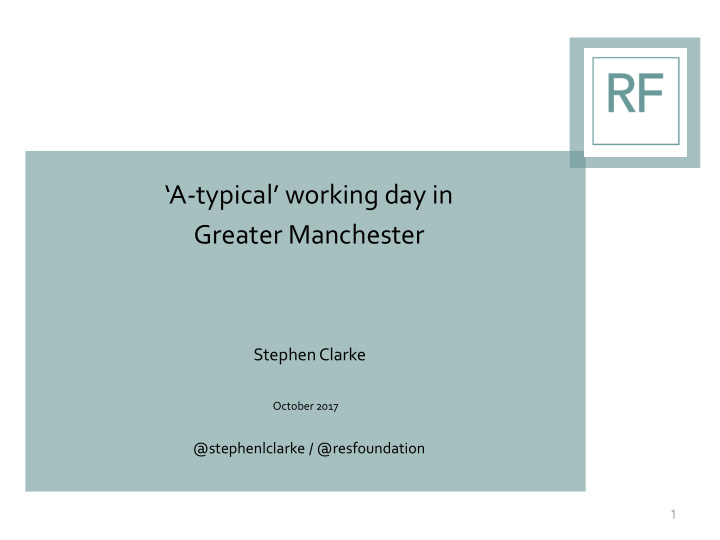



‘A - typical’ working day in Greater Manchester Stephen Clarke October 2017 @stephenlclarke / @resfoundation
T HE UK CONTEXT : M ORE WORK , AND MORE ‘ ATYPICAL ’ WORK
Employment at a record high and unemployment at a forty- year low…
…but significant growth in ‘atypical’ work
Full-time employees still account for the majority of those in work Note: to sum to 100% categories are mutually exclusive. We do this by splitting out agency workers and those on zero hours contracts (ZHC). Some people on ZHCs or working for an agency will be FT or PT workers. Some ZHC workers will be employed by an agency, but are just counted in the ZHC group
F INDING A JOB IN G REATER M ANCHESTER
Greater Manchester’s employment rate was once the envy of London, but no longer Notes: ‘Metro counties’ are Merseyside, West Midlands, Tyneside, South Yorkshire, and West Yorkshire
Greater Manchester has fallen down the rankings to mid-table since 2005
Raising the employment rate is partly about providing opportunities for ‘disadvantaged’ groups
‘A TYPICAL ’ WORK IN THE REGION
Like the rest of the country there is evidence that there is more ‘underemployment’ than the official statistics suggest Notes : ‘Metro counties’ are Merseyside, West Midlands, Tyneside, South Yorkshire, and West Yorkshire
There are around 30,000 people on Zero Hours Contracts in Greater Manchester
There are around 35,000 agency workers in the region
There has also been strong growth in the number of self-employed people, who have accounted for 47 per cent of the jobs growth in the region since 2007 Except for Leeds, Bristol and London, the share of workers who are self-employed is higher in GM than in the other major city regions
P AY IN G REATER M ANCHESTER
People in ‘atypical’ forms of employment are paid less, even when we compare like-for-like workers • Those on ZHCs earn £0.93 less an hour • Those on temporary contracts earn £0.77 less • Permanent agency workers earn £0.34 less Notes: Figures refer to the pay- penalty for various workers assessed at the UK level. More details can be found in: http://www.resoluti onfoundation.org/ media/blog/a- typical-year/
The pay squeeze has bitten harder in Greater Manchester, particularly for men. Typical pay for men in Greater Manchester reached £13.80 before the crisis. It is now £12.40, a fall of 10 per cent
Typical pay for men in Greater Manchester is no higher than it was at the turn of the millennium Notes: 2017 data estimated using data from the Labour Force Survey (LFS) to project Annual Survey of Hours and Earnings (ASHE) data forward
Although the minimum wage and now NLW means that those at the bottom – particularly women - have been somewhat protected
There are currently 240,000 people on low pay in the region, though this is set to fall to 200,000 over the next few years
At this point the region will be performing (marginally) better than most other major cities in the north and midlands
The share of people on the minimum wage will double to 170,000 by 2020, making the progression challenge even more pressing
O CCUPATIONAL CHANGE , THE GENDER PAY GAP AND THE YOUNG
Women have experienced strong growth in highly paid professions, and fewer women work in mid- skilled/mid-paid jobs Notes: Size of the bubble represents the share of total hours worked (for both sexes) for each occupation in 2015-16
Although men have also experienced a rise in highly paid roles, there has been a decline in the share of men in mid-skilled/mid-paid jobs Notes: Size of the bubble represents the share of total hours worked (for both sexes) for each occupation in 2015-16
While there is no clear evidence of a widespread ‘hollowing’ out of the labour market, this is happening for the young Notes: Size of the bubble represents the share of total hours worked (for all ages) for each occupation in 2015-16
The pay squeeze and occupational shifts have significantly reduced the gender pay gap in Greater Manchester
C ONCLUSION
There are three current challenges • The decline in the performance of the region relative to the UK and London needs to be halted • Although it can provide flexibility for some workers, more needs to be done to address ‘atypical’ work • The pay squeeze means that living standards are stagnating in the region
And two that will loom large in the future • Encouraging progression in a world where pay differentials are compressed at the bottom of the labour market • Tackling occupational polarisation for younger workers
Recommend
More recommend